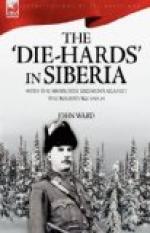After climbing the great Hinghan Range the plains of Mongolia came as a wonder to me. Imagine if you can a perfectly flat land through which your train glides hour after hour, day after day. The whole is covered with rough grass and a growth somewhat like a huge horse daisy or marguerite. At the time we passed these plants had dried, and a terrific wind sweeping over the plains had broken countless numbers of the dry herb off near the ground. They fell on their round sides. Directly the plants had lost their anchorage away they bounded like catherine wheels over the plains. It does not require much imagination to picture hundreds of thousands of these rounded tufts of dried grass bounding along over immense distances. It is quite a fascinating pastime to select a few of the larger and better formed ones coming over the horizon and calculate how long they take to arrive opposite your position. Calculations made in this way convinced me that a small coloured message properly fastened to these moving objects might have been carried five hundred miles in twenty-four hours. If, instead of looking at one, you look at the whole, the impression is of the solid earth passing rapidly from west to east. There are occasional obstructions in the shape of a huge flock of sheep which would cover half of Rutlandshire. These are herded by quaintly dressed Mongolian Tartars, on wonderful shaggy-haired horses, who ride at a furious pace around their flocks and guard them from attack by the wolves which infest this part of the world. It is worth recording how they do so. The wolf is a very cunning animal who has numerous methods of attack, and, like a hare, is very difficult to locate if in his form and practically level with the ground. But his very cunning is often his undoing. On no account will the wolf allow a string on which there are little coloured rags fluttering to pass over him, nor will he willingly get near it. The Tartar herdsmen go forward in line over the plain in the direction their flocks are feeding with a small strong string with little coloured flags fluttering along it, fastened




